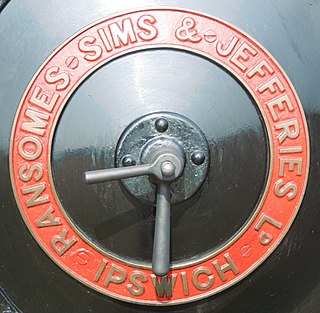
Ransomes, Sims and Jefferies Limited was a major British agricultural machinery maker also producing a wide range of general engineering products in Ipswich, Suffolk including traction engines, trolleybuses, ploughs, lawn mowers, combine harvesters and other tilling equipment. Ransomes also manufactured Direct Current electric motors in a wide range of sizes, and electric forklift trucks and tractors. They manufactured aeroplanes during the First World War. Their base, specially set up in 1845, was named Orwell Works.
The Mexborough and Swinton Traction Company was the name adopted by the Mexborough & Swinton Tramways Company in 1929 following the introduction of trolleybuses on all its routes. It operated in the West Riding of Yorkshire, England, over routes serving Manvers Main Colliery, Wath upon Dearne and the towns of Rotherham, Rawmarsh, Swinton, Mexborough, Conisbrough and the estate at Conanby.
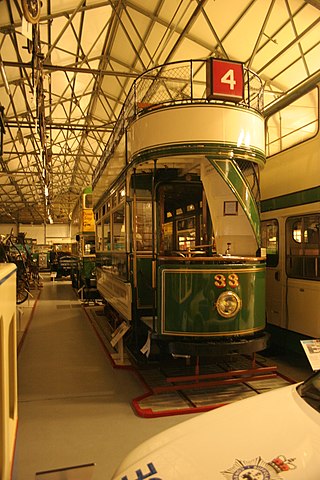
The Ipswich Transport Museum is a museum in Ipswich, Suffolk, England, devoted principally to the history of transport and engineering objects made or used in its local area.

The Wolverhampton trolleybus system served the city of Wolverhampton, then in Staffordshire, England, for much of the twentieth century.

Trolleybuses served the London Passenger Transport Area from 1931 until 1962. For much of its existence, the London system was the largest in the world. It peaked at 68 routes, with a maximum fleet of 1,811 trolleybuses.

The Huddersfield trolleybus system once served the market town of Huddersfield, in West Yorkshire, England. Opened on 4 December 1933, it gradually replaced the Huddersfield tramway network, which closed on Saturday, 29 June 1940.

The Rotherham trolleybus system once served the town of Rotherham, West Riding of Yorkshire, England. Opened on 3 October 1912, it was the fourth trolleybus system to be established in the United Kingdom, after the systems in nearby Bradford and Leeds, which had opened simultaneously in 1911, and Dundee earlier in 1912. Between 1912 and 1949, the Rotherham system gradually replaced the Rotherham Tramway.
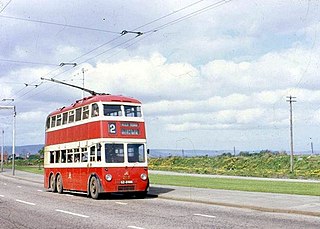
The Belfast trolleybus system served the city of Belfast, Northern Ireland. It was the only trolleybus system built in Ireland. Opened on 28 March 1938, it gradually replaced the city’s tramway network.

The Nottingham trolleybus system once served the city of Nottingham, in the county of Nottinghamshire, England. Opened on 10 April 1927, it gradually replaced the Nottingham tramway network.

The Reading trolleybus system served the town of Reading in the English county of Berkshire and was owned by Reading Corporation, who had operated an electric tramway since 1901. As there was a need for major refurbishment of the tramway in the 1930s, they decided to replace it with a trolleybus network. The first route was converted on 18 July 1936, and by mid 1939, trolleybuses were running over most of the tramway routes, with the last tram running on 20 May. By the standards of the various now-defunct trolleybus systems in the United Kingdom, the Reading system was a moderately sized one, with a total of four routes, and a maximum fleet of 63 trolleybuses, a size that lasted from 1 December 1950 to 27 March 1952.

The Walsall trolleybus system once served the town of Walsall, then in Staffordshire, but now in West Midlands, England. Opened on 22 July 1931, it gradually replaced the Walsall Corporation Tramways network.

The Ipswich trolleybus system once served Ipswich, the county town of Suffolk, England. Opened on 2 September 1923, it gradually replaced the Ipswich tramway network.

The Doncaster trolleybus system once served the town of Doncaster, South Yorkshire, England. Opened on 22 August 1928, it gradually replaced the Doncaster Corporation Tramways. By the standards of the various now-defunct trolleybus systems in the United Kingdom, the Doncaster system was a moderately sized one, with a total of 6 routes, all radiating out from the town centre, and a maximum fleet of 47 trolleybuses. The Bentley route was the first to close, on 12 February 1956, and the Beckett Road route was the last to go, on 14 December 1963.
The South Lancashire trolleybus system once served towns in South Lancashire, England, including Atherton, Bolton, Swinton and Leigh and St Helens. Opened on 3 August 1930, it replaced the South Lancashire Tramways network.
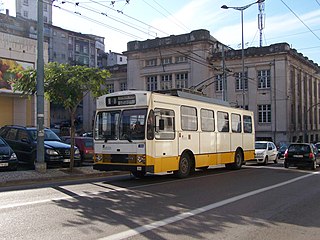
The Coimbra trolleybus system forms part of the public transport network in the city of Coimbra, Portugal. Opened in 1947, it supplemented, and then eventually replaced, the Coimbra tramway network. Service has been temporarily suspended since March 2021 and is not expected to resume before late 2024.

The York Corporation Tramways (YCT) provided an electric tramway and trolleybus service in York between 1910 and 1935.

Buses in Ipswich operate in the town of Ipswich in the English county of Suffolk. As of 2013 services are primarily operated by Ipswich Buses and First Norfolk & Suffolk, although other smaller operators, such as Galloway European, Carters Coaches and Beestons, operate routes from the town into the surrounding rural area. Many of the current routes are based on those established at the end of the 19th century when a horse tram network developed.
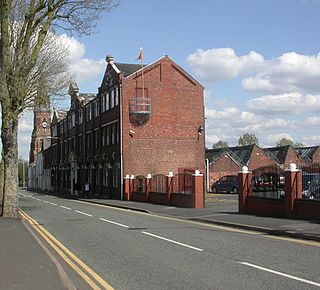
Sunbeam Commercial Vehicles was a commercial vehicle manufacturing offshoot of the Wolverhampton based Sunbeam Motor Car Company when it was a subsidiary of S T D Motors Limited. Sunbeam had always made ambulances on modified Sunbeam car chassis. S T D Motors chose to enter the large commercial vehicle market in the late 1920s, and once established they made petrol and diesel buses and electrically powered trolleybuses and milk floats. Commercial Vehicles became a separate department of Sunbeam in 1931.
Medellin, a City in western Colombia; important coffee center has returned its tramway as a modern tram system.
Bradford Corporation Tramways were a tramway network in the city of Bradford, West Riding of Yorkshire, England which operated trams from 1882 until 1950 and trolleybuses from 1911 until 1972. The track gauge of the tramways was 4 ft.
















